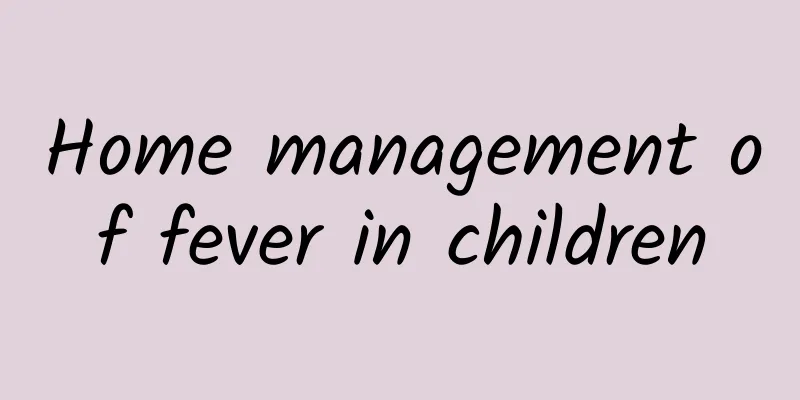Home management of fever in children

|
The normal body temperature of children is around 36 to 37°C. Occasionally it reaches 37.5°C, but the general body is in good condition and there are no clinical manifestations, which is still not pathological. There are various ways to measure body temperature. Traditionally, mercury thermometers are used, but mercury thermometers are easy to break during use, causing children to be exposed to mercury, and glass fragments are easy to cause accidental injuries. Therefore, in recent years, electronic thermometers and infrared thermometers have been tended to be used. Measurement time: 5 minutes for axillary table and 2 minutes for rectal table. The values measured by electronic thermometers and infrared thermometers are slightly lower than those of mercury thermometers. But it usually does not affect clinical judgment. Fever usually refers to a body temperature that is higher than the upper limit of normal fluctuations during the day. 37.5~38°C is low fever, 38.1~38.9°C is moderate fever, 39~41°C is high fever, and 41°C or more is hyperpyrexia. The causes of fever are complicated, but the mechanism of fever is clear. We know that the regulation and maintenance of body temperature is controlled by the body temperature regulation center. The body temperature center is located in the hypothalamus in the brain. The temperature setting point or set point is determined by regulating the heat production and heat dissipation. The normal body temperature setting point is around 37°C. This is like the air conditioner at home. After setting a temperature, the computer inside the machine will sense the ambient temperature and then adjust the working state of the compressor to maintain the temperature at the set value, which is similar to the body temperature regulation. It's interesting, isn't it? Things that seem complicated actually have simple principles. As the saying goes, simplicity is the best way. Most fevers are related to infection. Infection produces a substance called pyrogen, which raises the set point of our body temperature center, so the body temperature "rises". When fever occurs, the body's basal metabolism speeds up, the body temperature rises by one degree, metabolism increases by 13%, consumption increases, the spirit becomes excited, or listless, the digestive function decreases, the insensible water loss increases, and the body's stress state makes you feel strongly uncomfortable. Long-term fever can weaken the body's immunity and affect the recovery of the disease. Therefore, it is also necessary to adopt appropriate cooling measures and symptomatic treatment. For children with fever, we can take the following measures: 1. Warm water sponge bath, using the principle that the evaporation of water on the body surface takes away heat, we can use warm water sponge bath. The water temperature should not be too high and the time should not be too long. Usually the water temperature is slightly higher than the body temperature by about 3°C. Each time is about 5 minutes. It can be repeated many times. With oral antipyretics, the effect is better. However, it should be noted that some children will experience chills and shivering after sponge bathing, and feel obviously uncomfortable. In this case, it is not appropriate to use warm water sponge bathing. Sponge bathing with alcohol, ice water, etc. is not suitable for physical cooling of children. In addition to chills and shivering, it may cause the absorption of alcohol and the strong contraction of blood vessels in the skin, which will further increase the body temperature. 2. Cold compress, mostly on the forehead, armpits, and groin, where large blood vessels are superficial and suitable for cold compress, but the effect is limited. There are many cooling compress products on the market, but the effect is not better than cold towel application, so the cost performance is not reasonable. 3. Drugs for cooling down. Commonly used drugs include ibuprofen, acetaminophen, aspirin, nimesulide and diclofenac sodium. Such drugs can inhibit and reduce the synthesis of prostaglandins, and prostaglandins can precisely adjust the temperature center to an upward setting point. As mentioned above, upward adjustment can lead to fever, while downward adjustment can lead to cooling. Currently, WHO (World Health Organization) and the US FDA (US Food and Drug Administration) both recommend ibuprofen and acetaminophen as the first choice for children to reduce fever. Such drugs are safe and effective. It is not recommended to use aspirin and nimesulide for antipyretic treatment. In the last century, epidemiological surveys in the United States proved that Reye's syndrome, a disease that seriously damages the liver and nervous system, is related to oral aspirin. In recent years, there have been reports in China that children have used nimesulide to reduce fever and caused fulminant liver failure. Therefore, the safety of these two drugs is not ideal. It should be noted that the use of drugs to reduce fever is only symptomatic treatment and cannot replace causal treatment. When fever occurs, the cause of fever should be identified as soon as possible, and targeted treatment should be taken. This is the fundamental solution, and antipyretics should be considered only when the body temperature is higher than 38.5 degrees. For infants under three months old, physical cooling should be the main method, and antipyretics are not recommended. The combined use of different antipyretics, such as alternating use of ibuprofen and acetaminophen, has a more obvious antipyretic effect than the use of a single drug, but it cannot reduce the discomfort of the child. Antipyretics are mainly taken orally and anally, and intravenous and intramuscular injections are not recommended. Antipyretics are generally used for 3 days. Long-term use may mask the condition in addition to liver, kidney, and gastrointestinal damage caused by the drugs. In addition, the use of hormones is a very irresponsible practice, in addition to the need to suppress excessive inflammatory reactions in the body and the existence of corresponding indications. Although hormones have a strong antipyretic effect, which can be said to be immediate, they cannot be used as antipyretics because they severely suppress the body's immune response, affect metabolism, cause the spread of infection, and cause complications that should not have occurred, masking the condition and prolonging the course of the disease. Parents should be aware that it takes time for the condition to recover, and avoid inducing doctors to use hormones due to their anxiety and emotional excitement. Some misunderstandings about fever 1. The higher the body temperature, the more serious the condition. In fact, the severity of the disease is not in correspondence with the body temperature. In severe infections, the body temperature of infants and young children often drops instead of rising, which is a sign of a serious condition. Similarly, there is no clear positive correlation between the severity of the disease and the length of the fever and the responsiveness to antipyretic analgesics, but it may be helpful to indicate the cause of the disease. For example, long-term fever often indicates tuberculosis and rheumatic diseases. Parents should pay attention to some other symptoms associated with fever, such as consciousness, mental state, skin color, urine volume, skin elasticity, respiratory rate, and response to external stimuli. These indicators may be related to the severity of the disease. 2. Avoid eating when fever occurs. It is generally believed that eggs, milk and other animal ingredients can cause internal heat, and children should avoid eating them when they have fever or colds. In fact, this is nonsense and has no scientific basis. When fever occurs, metabolism speeds up, consumption increases, and nutritional needs also increase accordingly. It is more necessary to supplement nutritious and easy-to-digest foods. Milk and eggs are the best choices. It should be noted that the digestive ability decreases when fever occurs, and parents only need to flexibly grasp it according to the actual needs of the child. Most fevers do not cause serious damage to the body, but unlike adults, fever in some children can often lead to febrile convulsions, which is why parents are afraid of fever. In fact, the occurrence of febrile convulsions in children also has rules to follow, which can be prevented and treated. First of all, most febrile convulsions are related to genetics, which reminds us that if there is a family history of febrile convulsions, the probability of children having febrile convulsions will be greatly increased. Secondly, febrile convulsions have a high recurrence rate. When a child has a febrile convulsion, the chance of recurrence is greatly increased, and the body temperature during the second convulsion is lower than the body temperature during the first attack, and even convulsions will occur when the body temperature is around 38°C. Therefore, parents should not mistakenly think that febrile convulsions are convulsions caused by high fever. However, in a fever course, febrile convulsions often occur within the first 24 hours of the fever course, and most of them only have one convulsion. If there are multiple convulsions in a course of illness, be alert to intracranial infection. For recurrent febrile seizures, anticonvulsant drugs such as diazepam can be taken orally during the first 24 hours of fever for prevention. Fortunately, the prognosis of simple febrile seizures is mostly good. Author: Wang Lingli, deputy chief physician of Huangshan People's Hospital, Wang Dezhi, chief physician of Huangshan People's Hospital |
>>: How to check Helicobacter pylori infection? Is the blood test really reliable?
Recommend
Can pregnant women eat Panax notoginseng powder?
Pregnant women are a group of people who need spe...
What is the reason for a girl's period to come early?
The normal menstrual cycle of women is about 28 d...
What is the use of the OFF button on a car? What does the A button on a car mean?
In daily life, many people may often come into co...
In summer, if you eat this thing once, you will turn black
It is easy to get tanned in summer, but some peop...
What to do if your armpits have odor during pregnancy
What should I do if there is odor under my armpit...
Should women use paper to wipe after urinating?
Due to the special physiological characteristics ...
What kind of meat is used for braised beef? Home-cooked recipes for braised beef
Braised beef is a Shandong dish, and its flavors ...
How does breast augmentation with implants work?
Breast augmentation with implants is very familia...
Pictures of lochia almost finished
When the lochia is about to be discharged, it wil...
Spring Festival Health Guide: To ensure that the elderly have a healthy New Year, these “five don’ts” must be kept in mind!
As the Spring Festival approaches, every househol...
Anterior vaginal wall loss
The shedding of the anterior vaginal wall is also...
Bleeding after one week without bleeding
Once lovers reach a certain level of intimacy, se...
Minimally invasive re-ligation surgery
Bilateral tubal ligation is a contraceptive surgi...
What is the reason for a small lump in a woman's groin?
In daily life, the appearance of small bumps in t...
Pregnant women are prone to hemorrhoids. What should they do and what should they pay attention to in their diet?
Pregnancy is a very special time, because during ...








![[Medical Q&A] Can psoriasis treatment drugs induce cancer?](/upload/images/67f116a3a9aed.webp)
